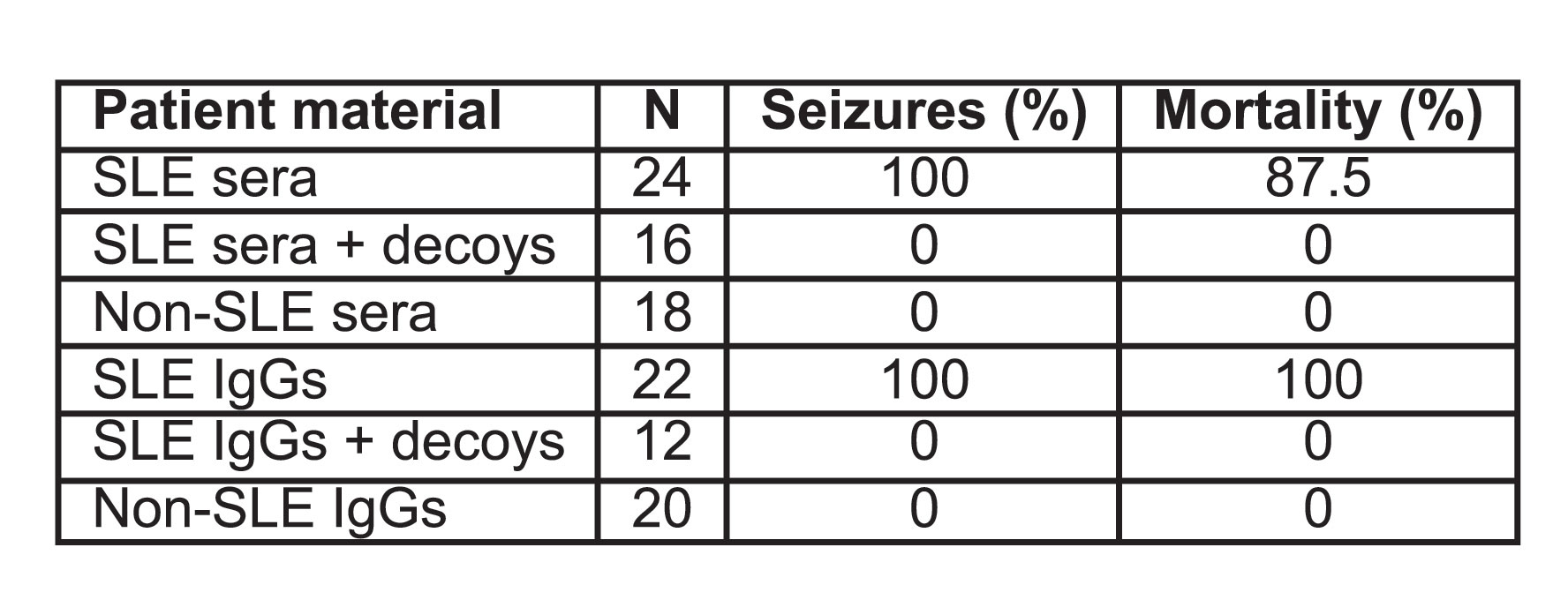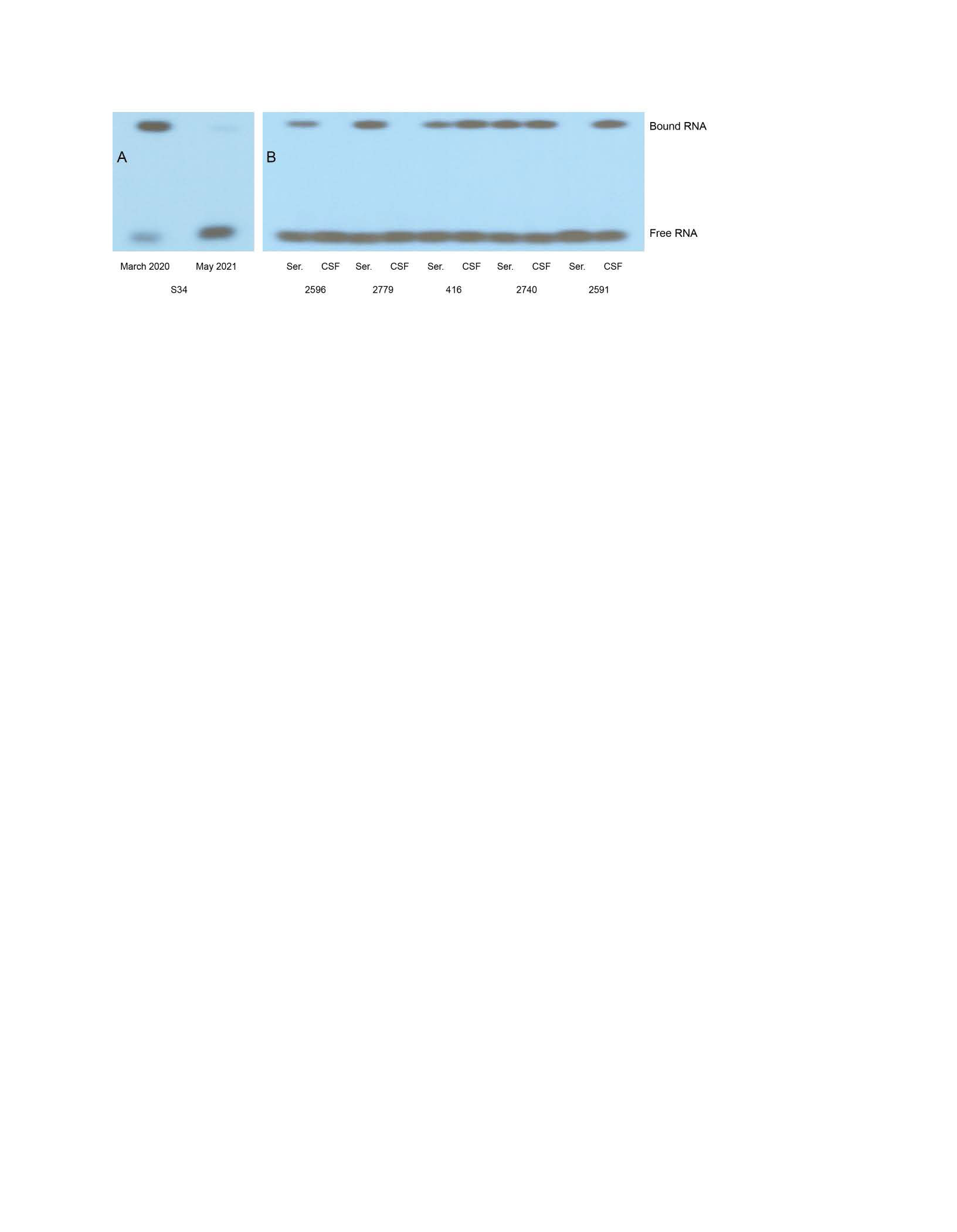Session Information
Session Type: Abstract Session
Session Time: 5:00PM-6:00PM
Background/Purpose: Neuropsychiatric (NP) involvement is common in systemic lupus erythematosus (SLE). Manifestations often include seizures and cognitive impairment but underlying etiology remains poorly understood. Brain Cytoplasmic (BC) RNAs are regulatory RNAs that control neuronal protein synthesis in postsynaptic microdomains. Lack of BC RNAs at neuronal synapses has been associated with seizures and cognitive impairment. The current study evaluates SLE autoantibodies directed against BC RNAs (anti-BC abs) as a cause of seizures.
Methods: SLE anti-BC abs — BC RNA interactions and displacement of RNA transport factors were analyzed by electrophoretic mobility shift assays (EMSAs). Sera or purified IgG from SLE patients presenting with seizures were i.v. injected into mice with a temporarily permeabilized blood-brain barrier. Seizure susceptibility and mortality of injected animals were scored following auditory stimulation.
Results: BC RNA synapto-dendritic targeting relies on interactions with two RNA transport factors, hnRNP A2 and Purα. We report that in human BC200 RNA, a guanosine-adenosine (GA) dendritic transport motif in the apical 5′ stem-loop domain interacts with both RNA transport factors and directs delivery of the RNA to synapto-dendritic domains in neurons. The same BC200 RNA GA motif is recognized by autoantibodies from a subset of patients with NPSLE, in particular those with seizures. These autoantibodies quasi irreversibly displace both RNA transport factors from the BC200 RNA GA motif, as a result causing intracellular mislocalization and synapto-dendritic lack of the RNA. The same autoantibodies were detected in cerebrospinal fluid (CSF) from NPSLE patients as follows: present in serum but not in CSF, 5 patients; present in both serum and CSF, 8 patients; present in CSF but not in serum, 3 patients; present in neither serum nor CSF, 5 patients; total number of patients examined: 21. A strong temporal association was observed between clinical manifestations (i.e. seizure activity) and SLE anti-BC RNA serum levels. To establish causality, naïve mice with a permeabilized blood-brain barrier were injected with SLE anti-BC RNA autoantibodies purified from patients with seizures. Treated mice developed severe seizure susceptibility with a 100% mortality. Seizure activity was completely averted when animals were injected with SLE anti-BC RNA autoantibodies neutralized with autoantigen (BC200 RNA or derivatives; Fisher’s exact test, P < 0.0001).
Conclusion: Seizures are a common but poorly understood clinical manifestation in NPSLE, and our work identifies SLE anti-BC RNA autoantibody activity as a mechanistic cause. These data demonstrate potential utility of BC200 RNA decoys for autoantibody-specific therapeutic interventions directed at SLE seizures.
Animals in the SLE sera/IgGs + decoys group were coinjected with sera/IgGs and BC200 decoys. Full-length BC200 RNA and the BC200 5’ domain were used as BC200 decoys.
Fisher’s exact test, P < 0.0001.
(A) Brooklyn SLE patient S34 (m, age 24) was admitted with recurrent severe seizures in March 2020 (high anti-BC200 reactivity in serum). He reported back after having been seizure-free for more than a year (low anti-BC200 reactivity in serum).
(B) Nova Scotia NPSLE paired patient sera and CSF were examined. Differential anti-BC200 CSF vs. serum reactivities were apparent as follows. In patient 2596, reactivity was robust in serum but absent from CSF; in patients 2779, 416, and 2740, reactivity was robust in both serum and CSF (serum levels > CSF levels for patient 2779, CSF > serum for patient 416, and serum ≈ CSF for patient 2740); in patient 2591, reactivity was robust in CSF but absent from serum. Data shown represent samples from 5 out of a total of 24 examined patients. Neuropsychiatric symptoms of these patients included acute confusion, psychosis, and seizures.
To cite this abstract in AMA style:
Tiedge H, MUSLIMOV I, Berardi V, Stephenson S, Ginzler E, Askanase A, Hanly J. Autoimmune RNA Dysregulation and Seizures: Therapeutic Prospects in Neuropsychiatric Systemic Lupus Erythematosus [abstract]. Arthritis Rheumatol. 2022; 74 (suppl 9). https://acrabstracts.org/abstract/autoimmune-rna-dysregulation-and-seizures-therapeutic-prospects-in-neuropsychiatric-systemic-lupus-erythematosus/. Accessed .« Back to ACR Convergence 2022
ACR Meeting Abstracts - https://acrabstracts.org/abstract/autoimmune-rna-dysregulation-and-seizures-therapeutic-prospects-in-neuropsychiatric-systemic-lupus-erythematosus/



